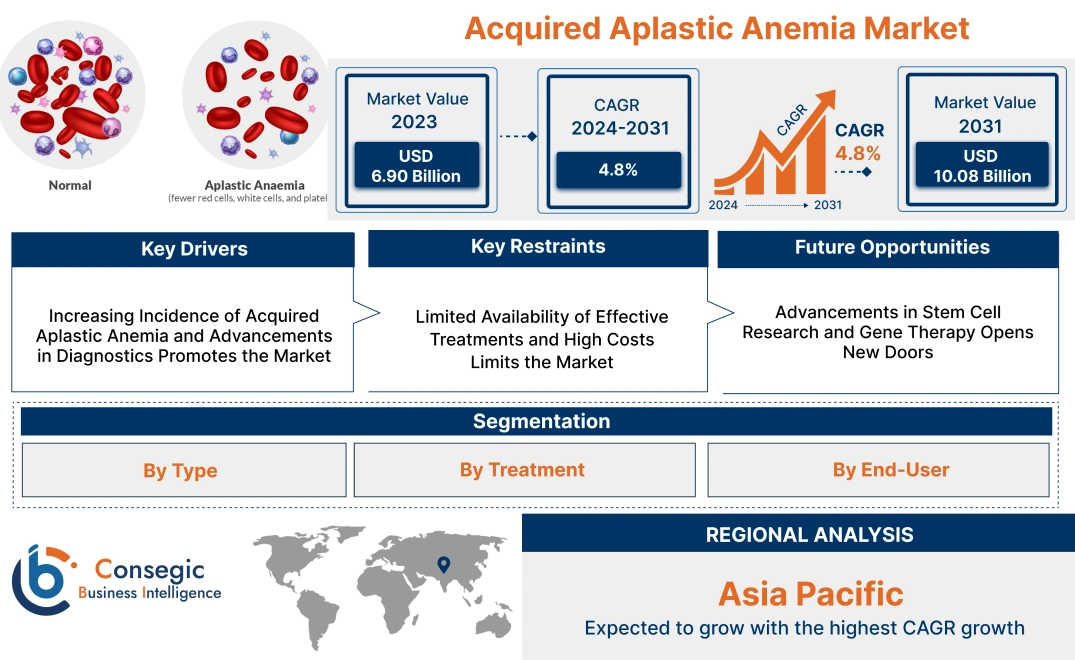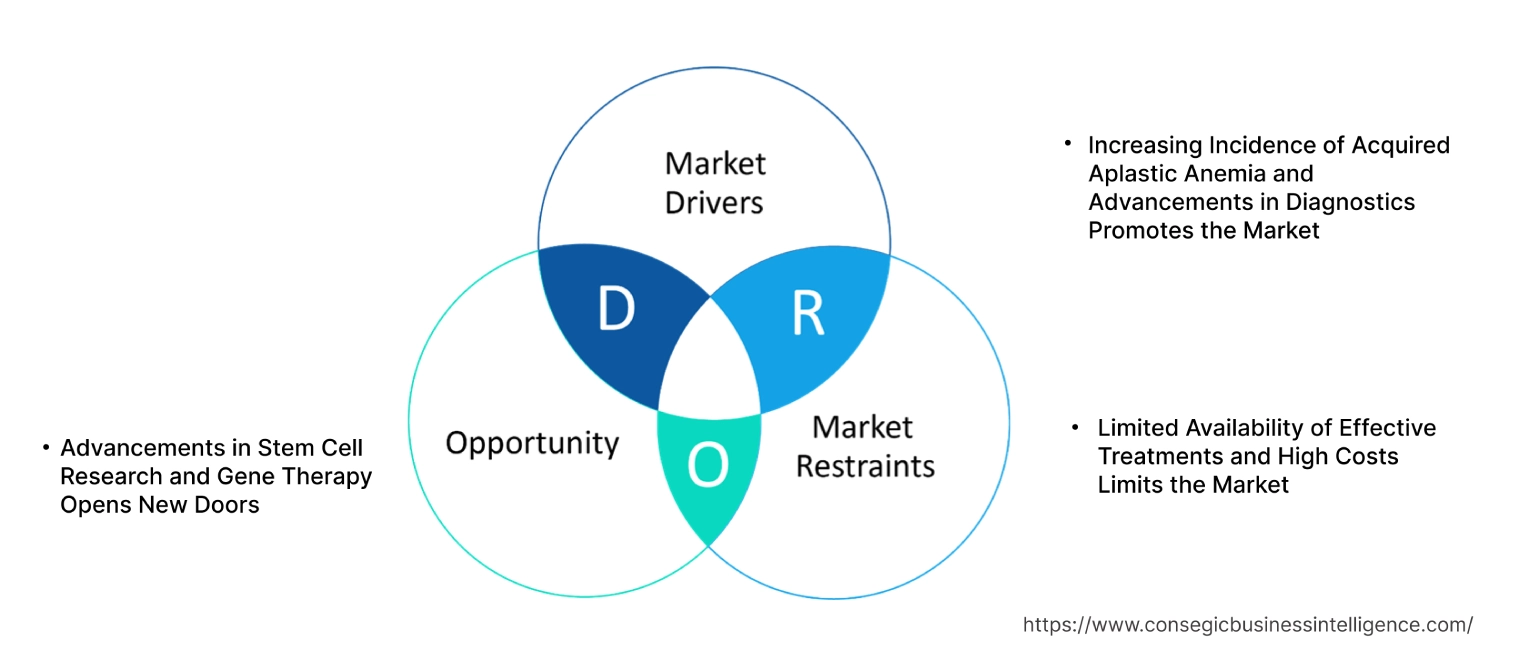Acquired Aplastic Anemia Market Size:
Acquired Aplastic Anemia market size is estimated to reach over USD 10.08 Billion by 2031 from a value of USD 6.90 Billion in 2023 and is projected to grow by USD 7.11 Billion in 2024, growing at a CAGR of 4.8% from 2024 to 2031.
Acquired Aplastic Anemia Market Scope & Overview:
Acquired aplastic anemia is a rare but serious blood disorder where the bone marrow fails to produce enough blood cells, leading to anemia, infection risks, and bleeding complications. This condition is typically caused by immune system dysfunction, exposure to certain medications, chemicals, or viral infections. Treatment options include immunosuppressive therapy, blood transfusions, and in severe cases, bone marrow transplants, which aim to restore healthy blood cell production and improve patient outcomes. Hospitals, specialty clinics, and research institutions play a critical role in patient care and advancing treatment options. End-use sectors, including healthcare providers and pharmaceutical companies, are focusing on improving therapeutic approaches and patient outcomes in managing this condition.
How is AI Impacting the Acquired Aplastic Anemia Market?
AI is impacting the Acquired Aplastic Anemia (AAA) market by revolutionizing various aspects of patient care and drug development. In diagnosis, AI-powered systems analyze complex clinical and laboratory data, including bone marrow smears, to achieve earlier and more accurate identification of AAA, differentiating it from other blood disorders. This precision can significantly improve patient outcomes. For treatment, AI accelerates drug discovery by identifying potential therapeutic targets and optimizing new drug formulations, including novel immunosuppressants and thrombopoietin receptor agonists. AI also aids in predicting patient response to therapies and developing personalized treatment plans.
Acquired Aplastic Anemia Market Dynamics - (DRO) :
Key Drivers:
Increasing Incidence of Acquired Aplastic Anemia and Advancements in Diagnostics Promotes the Market
The rising incidence of acquired aplastic anemia, a rare but serious condition characterized by bone marrow failure, is a significant driver of acquired aplastic anemia market growth. The disorder, which can be triggered by various factors such as viral infections, autoimmune diseases, or exposure to toxic chemicals, leads to a deficiency of red and white blood cells and platelets. As awareness of the condition grows, coupled with advancements in diagnostic tools like bone marrow biopsies and flow cytometry, more cases are being accurately identified and treated earlier. Additionally, the use of advanced molecular diagnostic techniques has improved the ability to differentiate acquired aplastic anemia from other bone marrow failure syndromes, allowing for more precise treatment approaches. The growing emphasis on early diagnosis and intervention is helping to expand the demand for treatments, particularly immunosuppressive therapies and hematopoietic stem cell transplants.
Key Restraints :
Limited Availability of Effective Treatments and High Costs Limits the Market
A major restraint in the market is the limited availability of effective treatment options and the high cost associated with advanced therapies. While hematopoietic stem cell transplantation (HSCT) offers a potential cure, it is only suitable for a subset of patients, particularly those with a compatible donor. For many patients, immunosuppressive therapy (IST) remains the primary treatment, but it may not provide a lasting cure and is associated with risks of relapse and infection. Additionally, the high cost of both HSCT and IST limits access to these treatments, particularly in lower-income regions and countries with less-developed healthcare infrastructures. This lack of curative options and the financial burden on patients and healthcare systems present significant challenges to broader acquired aplastic anemia market demand.
Future Opportunities :
Advancements in Stem Cell Research and Gene Therapy Opens New Doors
The ongoing advancements in stem cell research and gene therapy present promising acquired aplastic anemia market opportunities. Stem cell transplantation is currently the most effective curative option, and continued innovations in stem cell sourcing, including the use of haploidentical and umbilical cord stem cells, are expanding treatment possibilities for patients without fully matched donors. Moreover, gene therapy is being explored as a potential future treatment option for acquired aplastic anemia, targeting the underlying genetic and molecular pathways responsible for the condition. Although still in early stages of development, gene therapy has the potential to provide a more targeted and permanent solution, reducing the reliance on immunosuppressive treatments and offering new hope for patients. The increasing investment in these advanced therapeutic approaches is expected to drive future market development as these treatments progress through clinical trials and gain regulatory approval.
Acquired Aplastic Anemia Market Segmental Analysis :
By Type:
Based on type, the market is segmented into moderate aplastic anemia (MAA), severe aplastic anemia (SAA), and very severe aplastic anemia (VSAA).
The severe aplastic anemia (SAA) segment accounted for the largest revenue share of 48.24% in 2023.
- Severe aplastic anemia (SAA) is the most common and critical form of the disease, often requiring immediate medical intervention.
- SAA results in a significantly reduced production of red blood cells, white blood cells, and platelets, leading to life-threatening conditions.
- The growing incidence of SAA, coupled with the development of advanced therapeutic options such as immunosuppressive therapy (IST) and bone marrow transplantation (BMT), is driving the dominance of this segment.
- The availability of new treatment protocols and the increasing use of immunosuppressive drugs have also contributed to the segment's growth.
- Thus, as per the market trends analysis, the SAA dominates the market due to its high incidence and the critical need for advanced therapeutic options, including immunosuppressive therapy and bone marrow transplantation, driving the acquired aplastic anemia market demand.
The very severe aplastic anemia (VSAA) segment is anticipated to register the fastest CAGR during the forecast period.
- VSAA is the most life-threatening form of aplastic anemia, characterized by extremely low blood cell counts and severe bone marrow failure.
- The growing recognition of this condition and the increasing focus on early diagnosis and aggressive treatment strategies are driving the VSAA segment.
- Advances in bone marrow transplantation and improvements in supportive care, such as blood transfusions and growth factor administration, are contributing to better outcomes for patients with VSAA.
- The rising demand for innovative treatments to manage VSAA is expected to propel this segment's development.
- Thus, the segmental trends analysis depicts that VSAA is expected to grow rapidly due to increasing awareness, advancements in treatment protocols, and the rising need for aggressive intervention in life-threatening cases, boosting the acquired aplastic anemia market trends.
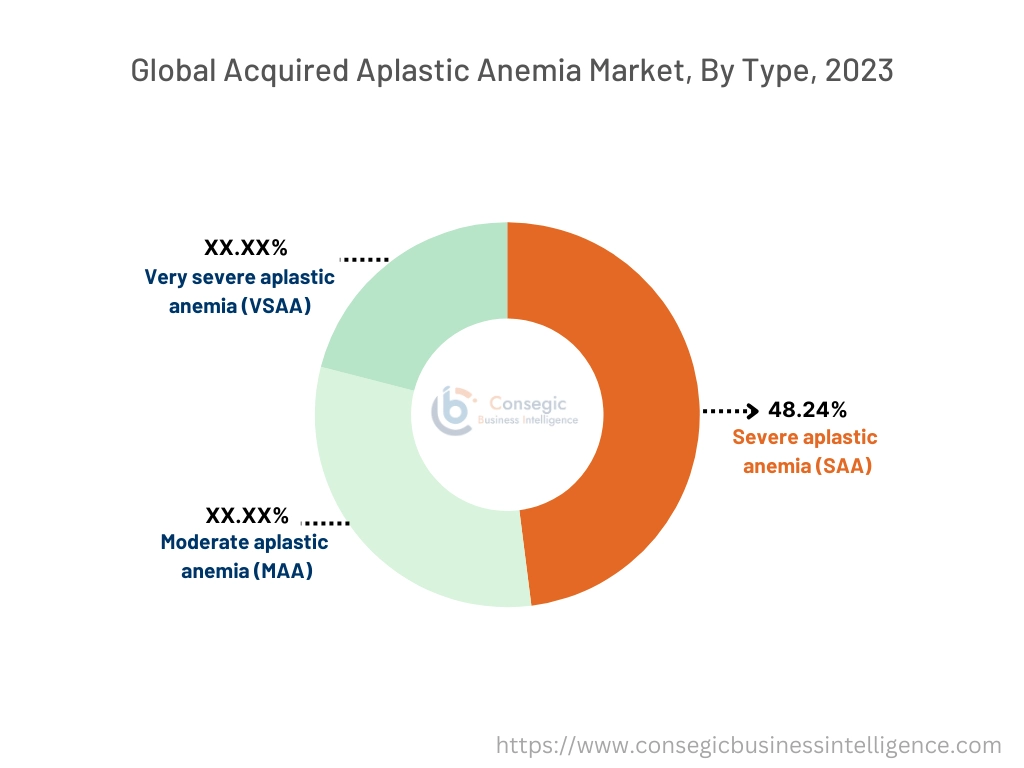
By Treatment:
Based on treatment, the market is segmented into immunosuppressive therapy (IST), anti-thymocyte globulin (ATG), cyclosporine, corticosteroids, bone marrow transplantation (BMT), blood transfusions, growth factors (G-CSF, erythropoietin), and others.
The immunosuppressive therapy (IST) segment accounted for the largest revenue share of the total acquired aplastic anemia market share in 2023.
- Immunosuppressive therapy (IST), particularly with anti-thymocyte globulin (ATG) and cyclosporine, is widely used in treating acquired aplastic anemia, especially for patients who are not suitable candidates for bone marrow transplantation.
- IST works by suppressing the immune system's attack on the bone marrow, allowing it to recover and produce blood cells.
- The combination of ATG and cyclosporine has proven highly effective in managing severe and very severe aplastic anemia, leading to high remission rates.
- The increasing use of IST as a first-line treatment for patients who lack suitable donors for BMT is driving the dominance of this segment.
- Thus, the segmental trends analysis depicts that immunosuppressive therapy leads the market due to its effectiveness in managing severe aplastic anemia, particularly in patients without access to bone marrow transplantation, making it a widely adopted treatment option, boosting the acquired aplastic anemia market growth.
The bone marrow transplantation (BMT) segment is anticipated to register the fastest CAGR during the forecast period.
- Bone marrow transplantation (BMT) is considered the curative treatment for aplastic anemia, especially for younger patients or those with matched donors.
- With advancements in BMT techniques, including haploidentical and unrelated donor transplants, the success rates of this treatment have improved significantly.
- The increasing availability of stem cell donors, coupled with technological advancements in BMT, is driving the segment.
- Additionally, the growing number of patients undergoing allogeneic BMT, which replaces damaged bone marrow with healthy donor cells, is contributing to the segment's rapid expansion.
- Therefore, the acquired aplastic anemia market analysis shows that one marrow transplantation is expected to grow rapidly, driven by advancements in transplantation techniques and the increasing availability of donors, positioning it as the curative option for aplastic anemia.
By End-User:
Based on end-user, the market is segmented into hospitals, specialty clinics, research institutes, and others.
The hospitals segment accounted for the largest revenue of the total acquired aplastic anemia market share in 2023.
- Hospitals play a central role in the diagnosis and treatment of acquired aplastic anemia, offering a wide range of services, including bone marrow transplants, blood transfusions, and immunosuppressive therapy.
- Hospitals are equipped with the necessary infrastructure, such as hematology and oncology departments, to manage complex cases of aplastic anemia.
- The increasing number of hospital admissions for bone marrow failure disorders and the availability of advanced treatment options in hospitals make this segment the largest in the market.
- Additionally, hospitals serve as key centers for clinical trials and research related to novel treatments for aplastic anemia.
- As per the acquired aplastic anemia market analysis, hospitals lead the market due to their comprehensive care facilities, advanced treatment options, and the growing number of patients seeking specialized care for acquired aplastic anemia.
The specialty clinics segment is anticipated to register the fastest CAGR during the forecast period.
- Specialty clinics, particularly hematology and oncology centers, are becoming increasingly important for the outpatient management of acquired aplastic anemia.
- These clinics provide focused care, including regular monitoring, blood transfusions, and administration of immunosuppressive therapies, without the need for hospital admission.
- The growing preference for specialized care in outpatient settings, along with the convenience of accessing advanced treatments in a more personalized environment, is driving the segment.
- Additionally, specialty clinics often work closely with research institutes, facilitating access to the latest treatment options and clinical trials.
- The analysis of segmental trends concludes that specialty clinics are expected to grow rapidly due to the increasing demand for outpatient care, specialized treatment, and the convenience of accessing advanced therapies in dedicated settings, boosting the acquired aplastic anemia market trends.
Regional Analysis:
The regions covered are North America, Europe, Asia Pacific, the Middle East and Africa, and Latin America.
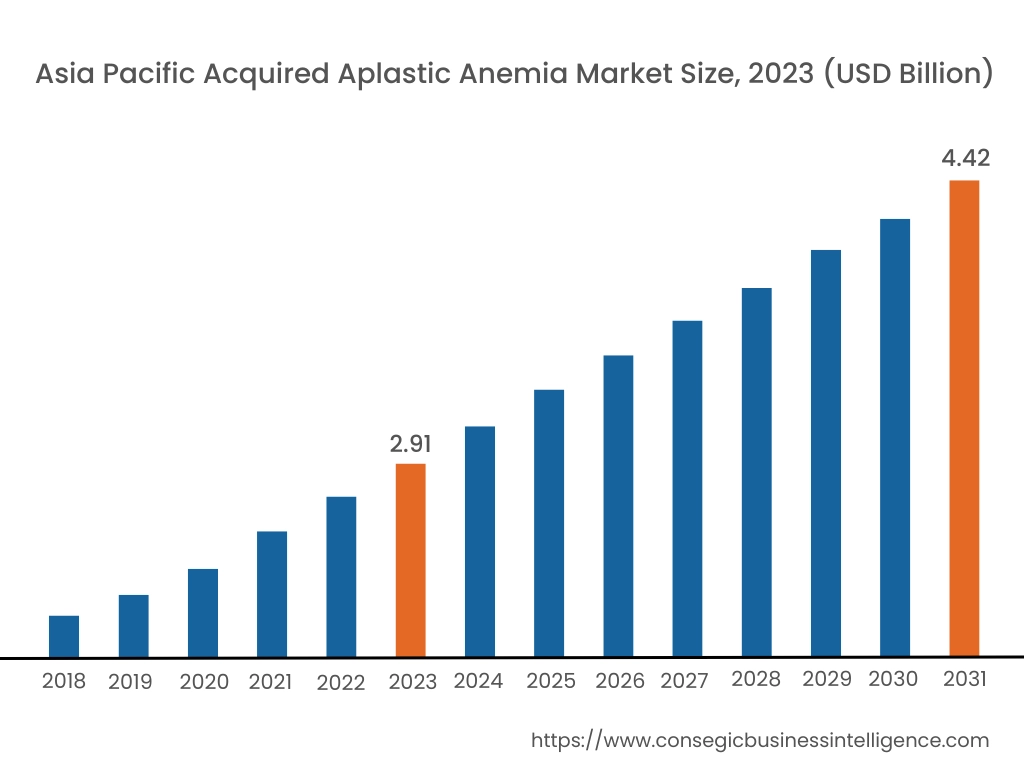
Asia Pacific region was valued at USD 2.91 Billion in 2023. Moreover, it is projected to grow by USD 3.01 Billion in 2024 and reach over USD 4.42 Billion by 2031. Out of this, China accounted for 31.3% of the total market share. Asia-Pacific is the fastest-growing region in the acquired aplastic anemia market, with China, Japan, and India driving the development. Rapid improvements in healthcare infrastructure and increasing access to advanced diagnostic tools contribute to early detection and treatment. The rising prevalence of blood disorders and government initiatives to improve healthcare access are key factors in market expansion. China and Japan are investing heavily in stem cell research and bone marrow transplant facilities. However, limited awareness, especially in rural areas, and a shortage of bone marrow donors continue to be significant challenges.
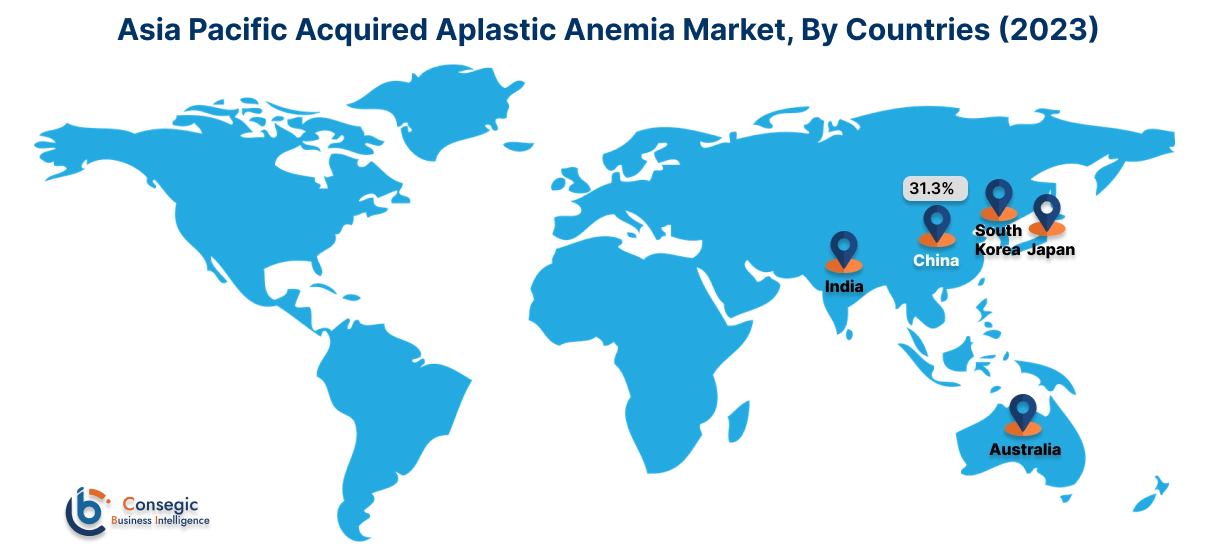
North America is estimated to reach over USD 2.29 Billion by 2031 from a value of 1.53 Billion in 2023 and is projected to grow by USD 1.58 Billion in 2024. North America is the largest market, driven by advanced healthcare infrastructure and significant investment in rare disease research. The U.S. leads the region due to a strong focus on bone marrow transplantation and innovative treatments, such as immunosuppressive therapies. Government funding and support for rare disease treatment, along with increasing awareness, contribute to the acquired aplastic anemia market expansion. However, the high cost of treatment and limited access to bone marrow donors pose challenges to wider adoption of advanced therapies.
The regional trends shows that Europe holds a significant share of the market, with countries like Germany, the UK, and France leading due to well-established healthcare systems and robust research capabilities. The European Union's initiatives for rare disease management and the availability of specialized treatment centers support market growth. Increasing access to hematopoietic stem cell transplants (HSCT) and growing awareness among healthcare professionals contribute to the demand for treatment. However, long waiting times for transplants and stringent regulatory requirements for new therapies can slow acquired aplastic anemia market expansion.
The Middle East & Africa region is experiencing steady growth in the market, with countries like Saudi Arabia, the UAE, and South Africa focusing on improving healthcare infrastructure. The demand for advanced treatments such as immunosuppressive therapies and bone marrow transplants is increasing due to rising awareness and government support. However, access to specialized care and high treatment costs remain barriers to market expansion, particularly in less developed parts of the region.
Latin America is an emerging market, led by Brazil and Mexico. The market is driven by improving healthcare systems and increasing access to treatments like blood transfusions and stem cell transplants. Government initiatives to raise awareness about rare diseases and improve healthcare access are supporting market growth. However, economic constraints and limited availability of advanced therapies in some countries pose challenges to the region's market development.
Top Key Players & Market Share Insights:
The Acquired Aplastic Anemia market is highly competitive with major players providing product and services to the national and international markets. Key players are adopting several strategies in research and development (R&D), product innovation, and end-user launches to hold a strong position in the global acquired aplastic anemia market. Key players in the acquired aplastic anemia industry include -
- Novartis International AG (Switzerland)
- Pfizer Inc. (USA)
- Sanofi S.A. (France)
- Roche Holding AG (Switzerland)
- AbbVie Inc. (USA)
- Amgen Inc. (USA)
- Janssen Pharmaceuticals, Inc. (USA)
- Eli Lilly and Company (USA)
- GlaxoSmithKline plc (UK)
- Takeda Pharmaceutical Company Limited (Japan)
Recent Industry Developments :
Mergers and Acquisitions:
- In April 2021, Amgen completed its tender offer to acquire Five Prime Therapeutics, a biotechnology company focusing on immuno-oncology and targeted cancer therapies, for $38.00 per share in cash. The total consideration for the acquisition amounts to approximately $1.9 billion after accounting for transaction fees.
- In December 2020, Bayer acquired Asklepios BioPharmaceutical (AskBio) to enhance its capabilities in the rapidly growing field of cell and gene therapy, positioning itself as an industry leader.
Acquired Aplastic Anemia Market Report Insights :
| Report Attributes | Report Details |
| Study Timeline | 2018-2031 |
| Market Size in 2031 | USD 10.08 Billion |
| CAGR (2024-2031) | 4.8% |
| By Type |
|
| By Treatment |
|
| By End-User |
|
| By Region |
|
| Key Players |
|
| North America | U.S. Canada Mexico |
| Europe | U.K. Germany France Spain Italy Russia Benelux Rest of Europe |
| APAC | China South Korea Japan India Australia ASEAN Rest of Asia-Pacific |
| Middle East and Africa | GCC Turkey South Africa Rest of MEA |
| LATAM | Brazil Argentina Chile Rest of LATAM |
| Report Coverage |
|
Key Questions Answered in the Report
How big is the Acquired Aplastic Anemia Market? +
Acquired Aplastic Anemia market size is estimated to reach over USD 10.08 Billion by 2031 from a value of USD 6.90 Billion in 2023 and is projected to grow by USD 7.11 Billion in 2024, growing at a CAGR of 4.8% from 2024 to 2031.
What is the Acquired Aplastic Anemia Market, and what factors drive its growth? +
The Acquired Aplastic Anemia Market focuses on treatments and therapies for patients with acquired aplastic anemia, a rare blood disorder where the bone marrow fails to produce enough blood cells. The market is driven by advancements in bone marrow transplantation, immunosuppressive therapy, and increasing awareness of rare blood disorders.
What are the primary treatment options for acquired aplastic anemia? +
The primary treatment options include bone marrow transplants, immunosuppressive therapy (using drugs like anti-thymocyte globulin and cyclosporine), and blood transfusions. In some cases, growth factors like erythropoietin and granulocyte-colony stimulating factor (G-CSF) are used to stimulate blood cell production.
Which region is expected to lead the Acquired Aplastic Anemia Market? +
North America is expected to lead the Acquired Aplastic Anemia Market due to the region's advanced healthcare infrastructure, availability of specialized treatment centers, and ongoing research into innovative therapies. Government initiatives supporting rare disease research also contribute to market growth in this region.
What challenges does the Acquired Aplastic Anemia Market face? +
The market faces challenges such as the high cost of treatment, limited availability of matched bone marrow donors, and potential complications from immunosuppressive therapies. Additionally, the rarity of the disease can make it difficult to fund large-scale research or clinical trials for novel treatments.
